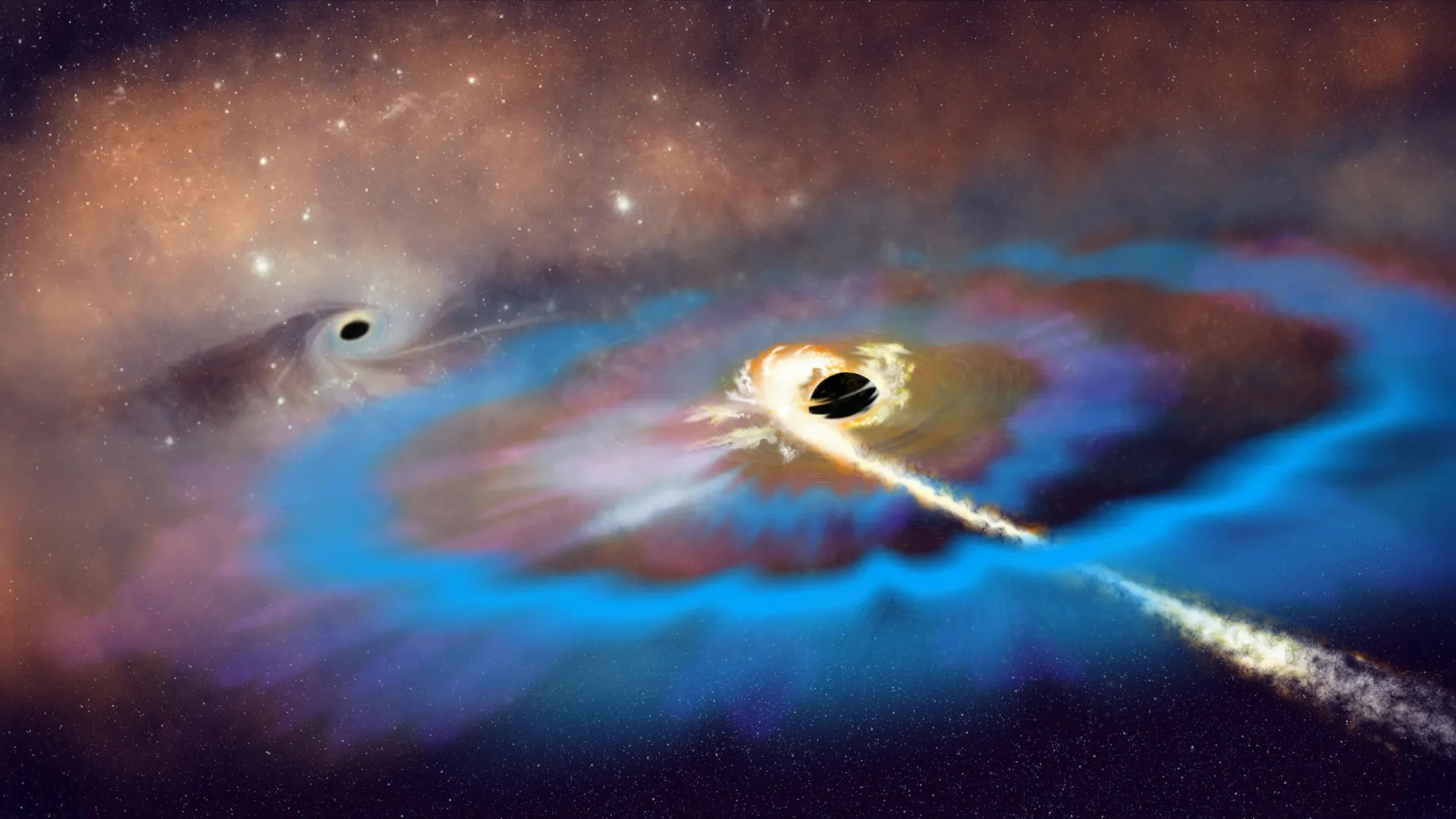Rogue black hole shocks astronomers with record radio blast
A rogue black hole shredded a star and unleashed record-fast radio flares, rewriting what we thought we knew about these cosmic beasts.
- Date:
- October 16, 2025
- Source:
- The Hebrew University of Jerusalem
- Summary:
- For the first time, scientists observed a black hole tearing apart a star far from its galaxy’s center, producing the fastest-changing radio signals ever recorded. The event, AT 2024tvd, revealed delayed bursts of energy months after the initial destruction, hinting at mysterious, episodic black hole activity. This rare find reshapes understanding of where supermassive black holes reside and how they evolve.
- Share:

For the first time, scientists have observed a tidal disruption event (TDE) -- a phenomenon in which a black hole rips apart a passing star -- taking place outside the central region of a galaxy. This unusual discovery revealed powerful and rapidly changing radio waves, showing that supermassive black holes can exist and stay active far beyond galactic centers. The delayed, intense radio bursts also point to previously unknown mechanisms in how black holes release material over extended periods.
An international team led by Dr. Itai Sfaradi and Prof. Raffaella Margutti of the University of California, Berkeley, together with collaborators from around the world, including Prof. Assaf Horesh of the Racah Institute of Physics at the Hebrew University of Jerusalem, identified the first TDE to produce bright radio signals away from a galaxy's core.
The event, named AT 2024tvd, exhibited the fastest-changing radio emission ever recorded from a black hole consuming a star.
"This is truly extraordinary," said Dr. Itai Sfaradi, the study's lead author. "Never before have we seen such bright radio emission from a black hole tearing apart a star, away from a galaxy's center, and evolving this fast. It changes how we think about black holes and their behavior."
Dr. Sfaradi, a former student of Prof. Horesh, led the groundbreaking research. "This is one of the fascinating discoveries I've been part of," said Prof. Horesh. "The fact that it was led by my former student, Itai, makes it even more meaningful. It's another scientific achievement that places Israel at the forefront of international astrophysics."
A black hole far from home
A tidal disruption event occurs when a star strays too close to a massive black hole and is pulled apart by its immense gravitational forces.
In this rare instance, the black hole was found roughly 2,600 light-years (0.8 kiloparsecs) from the center of its host galaxy -- strong evidence that supermassive black holes can exist in surprising and previously overlooked locations.
The key role of radio observations
The discovery was made possible through high-quality observations from several of the world's premier radio telescopes, including the Very Large Array (VLA), ALMA, ATA, SMA, and the Arcminute Microkelvin Imager Large Array (AMI-LA) in the UK.
The AMI observations, led by the Hebrew University team, were crucial in revealing the unusually rapid evolution of the radio emission -- a hallmark of this event and a major clue to understanding its physical nature.
The data showed two distinct radio flares evolving faster than any TDE observed before. These results indicate that powerful outflows of material were launched from the vicinity of the black hole not immediately after the stellar destruction, but months later, suggesting delayed and complex processes in the aftermath of the disruption.
Detailed modeling points to at least two separate ejection events, months apart -- clear evidence that black holes can episodically "reawaken" after periods of apparent inactivity.
The research was conducted in collaboration with scientists from institutions across the United States, Europe, and Israel, including Prof. Paz Beniamini of the Open University of Israel, and was published in The Astrophysical Journal Letters.
Story Source:
Materials provided by The Hebrew University of Jerusalem. Note: Content may be edited for style and length.
Journal Reference:
- Itai Sfaradi, Raffaella Margutti, Ryan Chornock, Kate D. Alexander, Brian D. Metzger, Paz Beniamini, Rodolfo Barniol Duran, Yuhan Yao, Assaf Horesh, Wael Farah, Edo Berger, Nayana A. J., Yvette Cendes, Tarraneh Eftekhari, Rob Fender, Noah Franz, Dave A. Green, Erica Hammerstein, Wenbin Lu, Eli Wiston, Yirmi Bernstein, Joe Bright, Collin T. Christy, Luigi F. Cruz, David R. DeBoer, Walter W. Golay, Adelle J. Goodwin, Mark Gurwell, Garrett K. Keating, Tanmoy Laskar, James C. A. Miller-Jones, Alexander W. Pollak, Ramprasad Rao, Andrew Siemion, Sofia Z. Sheikh, Nadav Shoval, Sjoert van Velzen. The First Radio-bright Off-nuclear Tidal Disruption Event AT 2024tvd Reveals the Fastest-evolving Double-peaked Radio Emission. The Astrophysical Journal Letters, 2025; 992 (2): L18 DOI: 10.3847/2041-8213/ae0a26
Cite This Page: